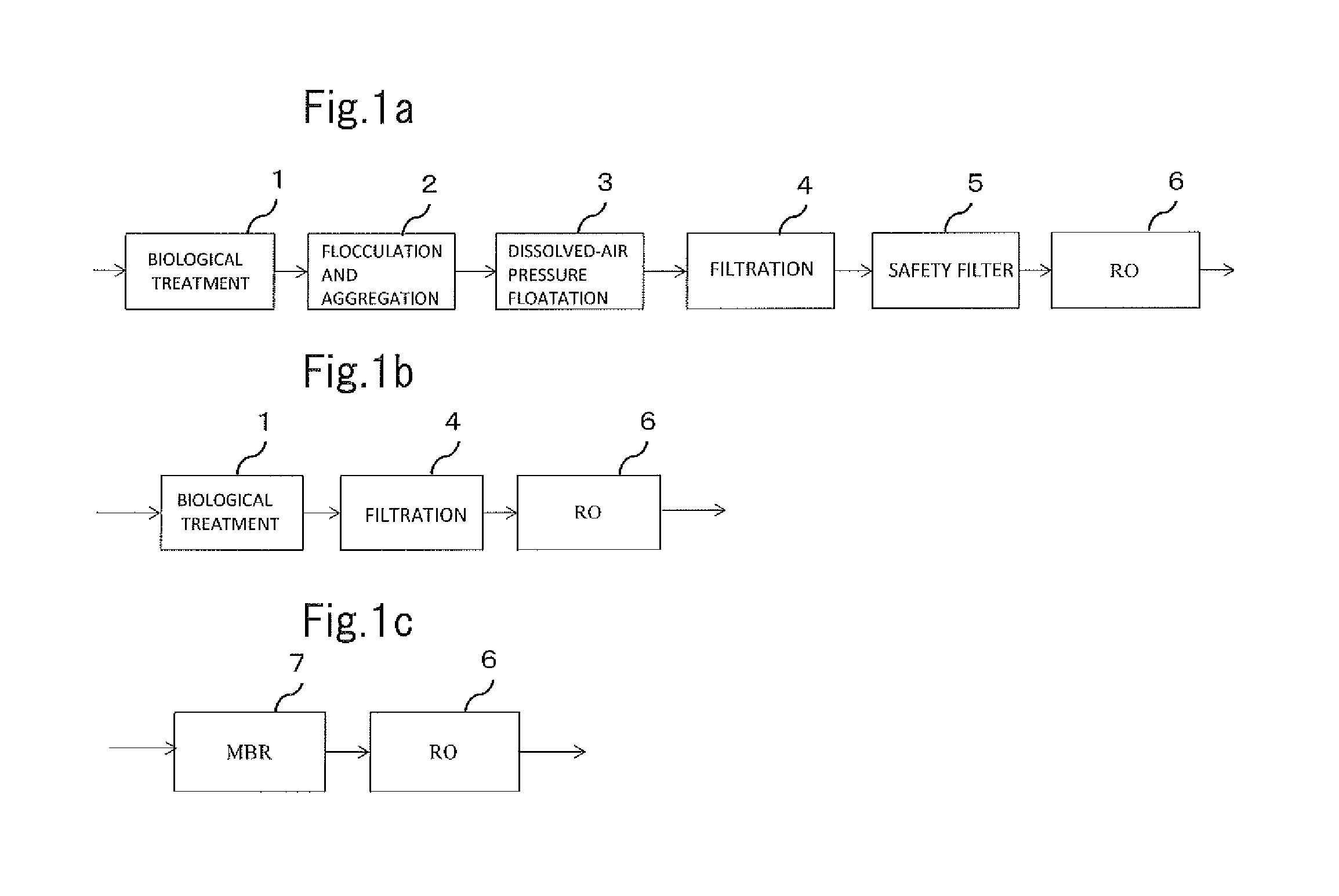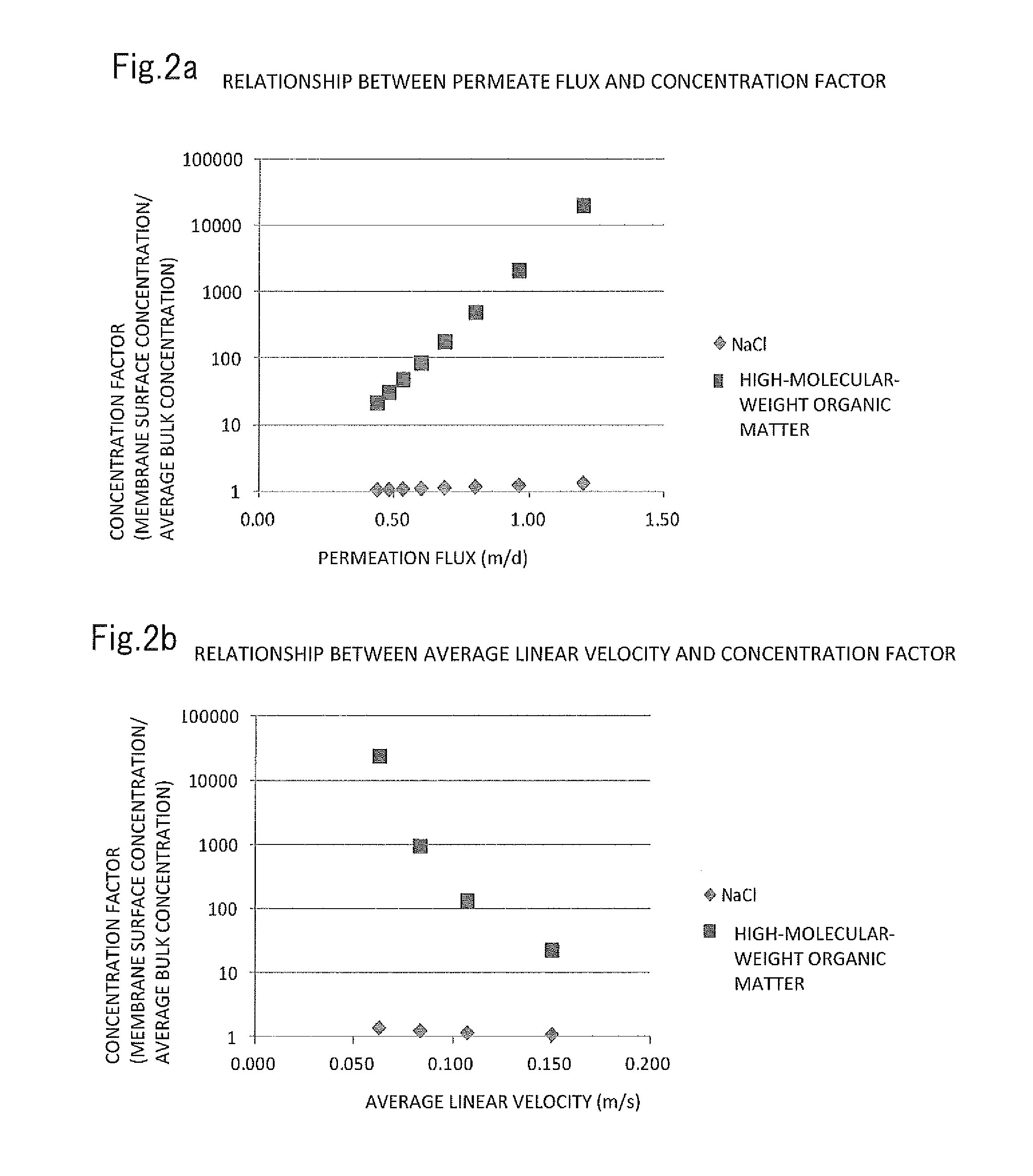Method for operating reverse osmosis membrane device, and reverse osmosis membrane device
a technology of reverse osmosis membrane and membrane device, which is applied in the direction of biological water/sewage treatment, filtration separation, and separation processes, etc., can solve the problems of clogging of channels with suspended matter, affecting the flow rate of membrane, so as to reduce the permeation rate , the effect of increasing the surface area of the membran
- Summary
- Abstract
- Description
- Claims
- Application Information
AI Technical Summary
Benefits of technology
Problems solved by technology
Method used
Image
Examples
reference example 1
[0054]Tables 1 and 2 below show the relationship between a thickness of a raw water spacer and a membrane surface area, and the relationship between permeate flux and linear velocity at a constant flow rate in a spiral-type reverse osmosis membrane element having a diameter of 8 inches (n2×(11 / 16)=44).
[0055]As is clear from Tables 1 and 2, reducing the thickness of the raw water spacer increases the membrane surface area per element, thereby reducing decreases in flux cansed by fouling. Too small a thickness of the raw water spacer, for example, 0.2 mm or less, leads to high hydraulic resistance, which heightens the risk of occlusion with suspended matter or similar.
TABLE 13 / h, andconcentrate flow rate: 5.1 m3 / h>Thickness ofMembraneraw water spacerPermeate fluxLinear velocitysurface area (m2)(mm)(m / d)(m / s)33.61.000.790.08637.10.860.710.09141.80.710.630.097440.650.600.10150.70.500.520.11463.60.300.420.15172.80.200.360.198
TABLE 23 / h, andconcentrate flow rate: 3.6 m3 / h>Thickness ofMemb...
reference example 2
[0056]The relationship between permeate flux or average linear velocity and concentration factor (membrane surface concentration / average bulk concentration) was analyzed in a reverse osmosis membrane separation process in which the raw water was an aqueous solution of NaCl or water containing high-molecular-weight organic matter having an average molecular weight of 10,000. The results are illustrated in FIGS. 2a and 2b.
[0057]As can be seen from FIGS. 2a and 2b, the concentration of high-molecular-weight organic matter on the membrane surface significantly rises with increasing permeate flux and decreasing average linear velocity in general, as compared with low-molecular-weight substances such as NaCl, although with some differences between polymer species.
example 1
[0058]The inventors assumed the use of an 8-inch spiral-type reverse osmosis membrane element having a membrane surface area of 44.0 m2. A flat-sheet membrane piece was cut out from a reverse osmosis membrane (a thickness of 0.13 mm) “ES20” of Nitto Denko Corporation to 50 mm in width×800 mm in length, and the piece was installed in a test flat-sheet membrane cell illustrated in FIG. 3 together with a 0.65 mm-thick mesh spacer of polypropylene as a raw water spacer (porosity 92%, mesh size 2.6 mm) and a 10 mm-thick ceramic (sintered porous ceramic) spacer as a permeate spacer.
[0059]The flat-sheet membrane cell illustrated in FIG. 3 has a structure in which a membrane unit is held in a space formed by channel-forming members of acrylic resin 21, 22, and 23 and pressure reinforcement members of SUS 24 and 25. The membrane unit is provide with a raw water spacer 11, a permeate spacer 12, and a reverse osmosis membrane 10 arranged therebetween.
[0060]The raw water flows from a raw water ...
PUM
| Property | Measurement | Unit |
|---|---|---|
| linear velocity | aaaaa | aaaaa |
| diameter | aaaaa | aaaaa |
| surface area | aaaaa | aaaaa |
Abstract
Description
Claims
Application Information
 Login to View More
Login to View More - R&D
- Intellectual Property
- Life Sciences
- Materials
- Tech Scout
- Unparalleled Data Quality
- Higher Quality Content
- 60% Fewer Hallucinations
Browse by: Latest US Patents, China's latest patents, Technical Efficacy Thesaurus, Application Domain, Technology Topic, Popular Technical Reports.
© 2025 PatSnap. All rights reserved.Legal|Privacy policy|Modern Slavery Act Transparency Statement|Sitemap|About US| Contact US: help@patsnap.com



